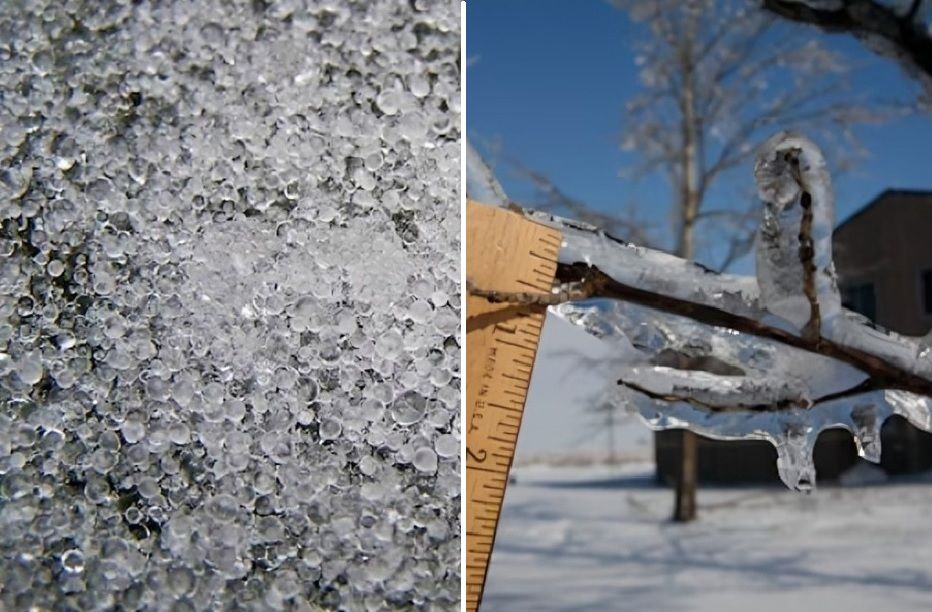
“
Freezing rain, a fascinating weather phenomenon, paints a delicate yet potentially hazardous picture across landscapes. This unique form of precipitation occurs when raindrops freeze upon contact with surfaces at or below freezing temperatures. Understanding freezing rain involves delving into its formation, impacts on daily life, and the challenges it presents to meteorologists. Join us as we uncover 20 intriguing facts about freezing rain, revealing its effects on travel, power systems, and the natural environment while appreciating its undeniable beauty amidst winter's grip.1
1
”
Freezing rain forms when warm, moist air overrides cold air at the surface. This phenomenon creates supercooled droplets that freeze upon contact with cold surfaces. The result is a layer of ice, which can be very hazardous. 1
The weight of ice from freezing rain can have catastrophic effects on infrastructure. Ice accumulation on power lines can lead to widespread blackouts and damage. Fallen trees from the weight can block roads and cause property damage. 2
Freezing rain creates exceptionally dangerous driving conditions. Roads can become coated in a slippery layer of ice, making it hard to maintain control. Drivers may underestimate the hazards, leading to numerous accidents. 3
Ice storms, characterized by extended freezing rain, can cause extensive damage. In 1998, a massive ice storm in Canada resulted in over $5 billion in damages. Trees and power lines were downed, creating chaos for emergency responders. 4

A slight change in temperature can dramatically affect precipitation type. When surface temperatures are below 32°F (0°C), rain turns into freezing rain. This temperature sensitivity can catch people off guard during winter storms.
The world record for the thickest ice accumulation from freezing rain was set in 1998. In some areas of Canada, ice layers exceeded 3 inches thick. Such extreme accumulation poses serious risks to both infrastructure and wildlife. 5
Freezing rain can severely damage trees, shrubs, and other plants. The weight of accumulated ice can break branches and uproot entire trees. This disruption affects not only aesthetics but also local ecosystems. 6
Freezing rain poses significant challenges for wildlife. Ice can limit birds' access to food sources, making survival difficult. Small mammals may find it hard to navigate through icy conditions. Adaptations and behaviors often shift as animals cope with harsh winter weather. 7
One of the deadliest freezing rain events occurred in the U.S. in 2007. It resulted in 23 fatalities and widespread disruptions across the Northeast. This event highlighted the dangers associated with freezing rain storms. 8
Freezing rain poses an extreme hazard to aircraft, leading to rapid structural icing that can freeze essential components. Most helicopters and small airplanes lack adequate deicing equipment for such conditions. 9
In 2018, a group in Canada set a record for the largest snow and ice sculpture during a freezing rain event. Despite the harsh conditions, their creativity shone through. This accomplishment showcases human resilience in the face of nature's challenges. 10

The aftermath of freezing rain leaves behind a fragile, glass-like veneer known as glaze ice, adorning landscapes with a surreal shimmer that belies its hazardous nature.
Prolonged freezing rain can negatively impact mental health. The dreary, gray conditions can lead to feelings of isolation and sadness. Many people experience Seasonal Affective Disorder (SAD) during long winter months. 11
Though similar, freezing rain and sleet are distinct weather phenomena. Sleet forms when frozen precipitation falls before hitting the ground. In contrast, freezing rain freezes upon contact with surfaces. 12
Many animals adapt their behaviors in response to freezing rain events. Squirrels may store extra food in preparation for harsh conditions. Birds often flock together for warmth and protection from the elements. 13
Hospitals typically see a rise in injuries during freezing rain events. Slips and falls are common as icy conditions make surfaces treacherous. Many people underestimate the dangers of walking on ice, leading to accidents. 14
Climate change may influence the frequency and severity of freezing rain events. Warmer winters could lead to more instances of freezing rain instead of snow. This shift has implications for infrastructure, agriculture, and wildlife. 15
Emergency services often prepare in advance for freezing rain situations. Stockpiling supplies and ensuring equipment readiness are crucial for effective responses. Rapid response teams are essential for clearing roads and restoring power. 16
Learning about freezing rain expands knowledge of weather phenomena, fostering curiosity and awareness of its profound influence on daily life and natural environments. 17
Despite its challenges, freezing rain offers glimpses of nature's resilience and creativity, showcasing its ability to transform landscapes into breathtaking yet perilous winter wonderlands. 18


